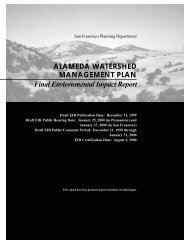Feasibility of Fish Passage at Alameda Creek Diversion Dam
Feasibility of Fish Passage at Alameda Creek Diversion Dam
Feasibility of Fish Passage at Alameda Creek Diversion Dam
Create successful ePaper yourself
Turn your PDF publications into a flip-book with our unique Google optimized e-Paper software.
1.0 Introduction1 INTRODUCTION1.1 BACKGROUND INFORMATIONThe San Francisco Public Utilities Commission (SFPUC) has been working with other stakeholders sincethe l<strong>at</strong>e 1980s to restore steelhead (Oncorhynchus mykiss) to the <strong>Alameda</strong> <strong>Creek</strong> W<strong>at</strong>ershed (TAC, 1989).In conjunction with other fisheries enhancement actions, the SFPUC removed Niles and Sunol dams from<strong>Alameda</strong> <strong>Creek</strong> in 2006 and is completing a Habit<strong>at</strong> Conserv<strong>at</strong>ion Plan th<strong>at</strong> includes steelhead as acovered species (SFPUC, 2009a). The SFPUC is also a member <strong>of</strong> the <strong>Alameda</strong> <strong>Creek</strong> <strong>Fish</strong>eriesRestor<strong>at</strong>ion Workgroup, which is working to restore steelhead to the <strong>Alameda</strong> <strong>Creek</strong> W<strong>at</strong>ershed. The<strong>Alameda</strong> <strong>Creek</strong> <strong>Fish</strong>eries Restor<strong>at</strong>ion Workgroup is composed <strong>of</strong> a broad range <strong>of</strong> stakeholders, includingrepresent<strong>at</strong>ives from the N<strong>at</strong>ional Marine <strong>Fish</strong>eries Service (NMFS) and the California Department <strong>of</strong> <strong>Fish</strong>and Game (CDFG).Steelhead entry into the <strong>Alameda</strong> <strong>Creek</strong> W<strong>at</strong>ershed from the ocean via San Francisco Bay is currentlyblocked by various w<strong>at</strong>er development and other projects in lower <strong>Alameda</strong> <strong>Creek</strong> (TAC, 1989; ETJVand ESA-Orion Joint Venture, 2008; SFPUC, 2008a). When migr<strong>at</strong>ing from the ocean to spawn infreshw<strong>at</strong>er, adult steelhead, which are listed as thre<strong>at</strong>ened 1 under the federal Endangered Species Act,are sometimes present in low numbers below the <strong>Alameda</strong> County Flood Control and W<strong>at</strong>erConserv<strong>at</strong>ion District (ACFCWCD) grade control structure (known as the BART weir), the firstcomplete barrier to upstream fish migr<strong>at</strong>ion in <strong>Alameda</strong> <strong>Creek</strong> (Figure 1-1). Efforts are underway tocre<strong>at</strong>e passage for steelhead <strong>at</strong> the BART weir and other barriers to migr<strong>at</strong>ion.The SFPUC oper<strong>at</strong>ions are loc<strong>at</strong>ed within the Upper <strong>Alameda</strong> <strong>Creek</strong> Sub-W<strong>at</strong>ershed (Figure 1-1),where the SFPUC oper<strong>at</strong>es San Antonio and Calaveras reservoirs and associ<strong>at</strong>ed w<strong>at</strong>er deliveryfacilities. Construction <strong>of</strong> the <strong>Alameda</strong> <strong>Creek</strong> <strong>Diversion</strong> <strong>Dam</strong> and Tunnel began in 1925 to secureadditional sources <strong>of</strong> w<strong>at</strong>er from the Upper <strong>Alameda</strong> <strong>Creek</strong> Sub-W<strong>at</strong>ershed for impoundment inCalaveras Reservoir. The SFPUC began diverting w<strong>at</strong>er from the Upper <strong>Alameda</strong> <strong>Creek</strong> Basin withthe completion <strong>of</strong> the diversion dam and tunnel in 1931 (SFPUC, 2004).Ongoing oper<strong>at</strong>ion <strong>of</strong> SFPUC facilities influences fish access to stream channel habit<strong>at</strong>s within theUpper <strong>Alameda</strong> <strong>Creek</strong> Sub-W<strong>at</strong>ershed. Once steelhead regain access to the w<strong>at</strong>ershed through theconstruction <strong>of</strong> fish passage facilities in the Lower <strong>Alameda</strong> <strong>Creek</strong> Sub-W<strong>at</strong>ershed (ACFCWCD andACWD, 2007) and re-enter the upper sub-w<strong>at</strong>ersheds, the <strong>Alameda</strong> <strong>Creek</strong> <strong>Diversion</strong> <strong>Dam</strong> (ACDD)will present any steelhead th<strong>at</strong> successfully immigr<strong>at</strong>e past Little Yosemite with an impassable barrierto upstream migr<strong>at</strong>ion. This memorandum, in conjunction with three other studies (URS and HDR,2009a, 2009b, and 2009c), provides inform<strong>at</strong>ion regarding upstream migr<strong>at</strong>ion conditions in theUpper <strong>Alameda</strong> <strong>Creek</strong> Sub-W<strong>at</strong>ershed.1.2 PURPOSEThe SFPUC has retained URS Corpor<strong>at</strong>ion and HDR (including both HDR|SWRI and HDR|<strong>Fish</strong>Pro’s<strong>Fish</strong>ery Design Center) to provide pr<strong>of</strong>essional fisheries and engineering services to evalu<strong>at</strong>e thefeasibility <strong>of</strong> providing fish passage and screening for anadromous steelhead <strong>at</strong> the ACDD. Inconjunction with ongoing efforts to remedy the barriers to passage, it is anticip<strong>at</strong>ed th<strong>at</strong> a run <strong>of</strong>anadromous steelhead will be restored to the <strong>Alameda</strong> <strong>Creek</strong> W<strong>at</strong>ershed (ETJV and ESA-Orion JointVenture, 2008). This technical memorandum describes the general design criteria, evalu<strong>at</strong>es1 Below n<strong>at</strong>ural and manmade impassable barriers, Central California Coast distinct popul<strong>at</strong>ion segment n<strong>at</strong>urallyspawned anadromous steelhead (Oncorhynchus mykiss) are listed as thre<strong>at</strong>ened under the federal Endangered SpeciesAct (NMFS, 2006).ACDD <strong>Passage</strong> June 2009 Page 1-1








